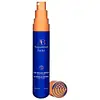What's inside
What's inside
 Key Ingredients
Key Ingredients

 Benefits
Benefits

 Concerns
Concerns

 Ingredients Side-by-side
Ingredients Side-by-side

Water
Skin ConditioningCaprylic/Capric Triglyceride
MaskingGlycerin
HumectantOctyldodecanol
EmollientC12-16 Alcohols
EmollientSqualane
EmollientPropanediol
SolventGlycine Soja Oil
EmollientButyrospermum Parkii Butter
Skin ConditioningEctoin
Skin ConditioningHelianthus Annuus Hybrid Oil
EmollientPalmitic Acid
EmollientMyristyl Alcohol
EmollientPCA
HumectantHydrogenated Lecithin
EmulsifyingXanthan Gum
EmulsifyingPotassium Sorbate
PreservativeCarbomer
Emulsion StabilisingSodium Stearoyl Glutamate
CleansingSodium Benzoate
MaskingHelianthus Annuus Seed Oil
EmollientTocopherol
AntioxidantCitric Acid
BufferingZinc PCA
HumectantMaltodextrin
AbsorbentRetinol
Skin ConditioningHydrolyzed Rice Protein
Skin ConditioningPanthenol
Skin ConditioningTotarol
AntioxidantLeptospermum Scoparium Branch/Leaf Oil
TonicNiacinamide
SmoothingSodium Hydroxide
BufferingCalcium Pantothenate
Sodium Starch Octenylsuccinate
AbsorbentMagnolia Officinalis Bark Extract
AntimicrobialPiper Nigrum Seed Extract
RefreshingTocopheryl Acetate
AntioxidantCamellia Sinensis Leaf Extract
AntimicrobialPolygonum Cuspidatum Root Extract
AntioxidantSodium Ascorbyl Phosphate
AntioxidantPyridoxine Hcl
Skin ConditioningAlanyl Glutamine
HumectantArginine
MaskingOligopeptide-177
Phenylalanine
MaskingSisymbrium Irio Seed Oil
MaskingSodium Chloride
MaskingSilica
AbrasiveWater, Caprylic/Capric Triglyceride, Glycerin, Octyldodecanol, C12-16 Alcohols, Squalane, Propanediol, Glycine Soja Oil, Butyrospermum Parkii Butter, Ectoin, Helianthus Annuus Hybrid Oil, Palmitic Acid, Myristyl Alcohol, PCA, Hydrogenated Lecithin, Xanthan Gum, Potassium Sorbate, Carbomer, Sodium Stearoyl Glutamate, Sodium Benzoate, Helianthus Annuus Seed Oil, Tocopherol, Citric Acid, Zinc PCA, Maltodextrin, Retinol, Hydrolyzed Rice Protein, Panthenol, Totarol, Leptospermum Scoparium Branch/Leaf Oil, Niacinamide, Sodium Hydroxide, Calcium Pantothenate, Sodium Starch Octenylsuccinate, Magnolia Officinalis Bark Extract, Piper Nigrum Seed Extract, Tocopheryl Acetate, Camellia Sinensis Leaf Extract, Polygonum Cuspidatum Root Extract, Sodium Ascorbyl Phosphate, Pyridoxine Hcl, Alanyl Glutamine, Arginine, Oligopeptide-177, Phenylalanine, Sisymbrium Irio Seed Oil, Sodium Chloride, Silica
Water
Skin ConditioningPropanediol
SolventDimethicone
EmollientCetearyl Ethylhexanoate
EmollientAlcohol Denat.
AntimicrobialAllyl Methacrylates Crosspolymer
Emulsion StabilisingDipropylene Glycol
HumectantAmmonium Polyacryloyldimethyl Taurate
Emulsion StabilisingAcrylamide/Sodium Acryloyldimethyltaurate Copolymer
Emulsion StabilisingRetinol
Skin ConditioningHydrogenated Lecithin
EmulsifyingPolysorbate 20
EmulsifyingIsohexadecane
EmollientPhenoxyethanol
PreservativeCaprylyl Glycol
EmollientIsopropyl Myristate
EmollientSodium Citrate
BufferingBoswellia Serrata Gum
MaskingPolysorbate 80
EmulsifyingBHT
AntioxidantDimethiconol
EmollientTrisodium Ethylenediamine Disuccinate
Bisabolol
MaskingSorbitan Oleate
EmulsifyingCitric Acid
BufferingPropyl Gallate
AntioxidantWater, Propanediol, Dimethicone, Cetearyl Ethylhexanoate, Alcohol Denat., Allyl Methacrylates Crosspolymer, Dipropylene Glycol, Ammonium Polyacryloyldimethyl Taurate, Acrylamide/Sodium Acryloyldimethyltaurate Copolymer, Retinol, Hydrogenated Lecithin, Polysorbate 20, Isohexadecane, Phenoxyethanol, Caprylyl Glycol, Isopropyl Myristate, Sodium Citrate, Boswellia Serrata Gum, Polysorbate 80, BHT, Dimethiconol, Trisodium Ethylenediamine Disuccinate, Bisabolol, Sorbitan Oleate, Citric Acid, Propyl Gallate
Ingredients Explained
These ingredients are found in both products.
Ingredients higher up in an ingredient list are typically present in a larger amount.
Citric Acid is an alpha hydroxy acid (AHA) naturally found in citrus fruits like oranges, lemons, and limes.
Like other AHAs, citric acid can exfoliate skin by breaking down the bonds that hold dead skin cells together. This helps reveal smoother and brighter skin underneath.
However, this exfoliating effect only happens at high concentrations (20%) which can be hard to find in cosmetic products.
Due to this, citric acid is usually included in small amounts as a pH adjuster. This helps keep products slightly more acidic and compatible with skin's natural pH.
In skincare formulas, citric acid can:
While it can provide some skin benefits, research shows lactic acid and glycolic acid are generally more effective and less irritating exfoliants.
Most citric acid used in skincare today is made by fermenting sugars (usually from molasses). This synthetic version is identical to the natural citrus form but easier to stabilize and use in formulations.
Read more about some other popular AHA's here:
Learn more about Citric AcidHydrogenated Lecithin is created from the hydrogenation of lecithin (a group of phospholipids). Hydrogenation is a chemical reaction between hydrogen and another element.
This ingredient is an emollient and emulsifier. As an emollient, it helps soften skin by trapping moisture within. As an emulsifier, it prevents oil and water ingredients from separating.
Propanediol is an all-star ingredient. It softens, hydrates, and smooths the skin.
It’s often used to:
Propanediol is not likely to cause sensitivity and considered safe to use. It is derived from corn or petroleum with a clear color and no scent.
Learn more about PropanediolRetinol is a gold-standard ingredient for anti-aging. It is a form of Vitamin A and belongs to the class of retinoids that also includes tretinoin.
Why is retinol famous?
It has the most scientific studies backing up its skin benefits out of all the non-prescription ingredients.
Retinol is proven to:
This is why retinol is effective at removing wrinkles, fading dark spots, treating acne, and reducing the appearance of pores.
Studies show retinol is less effective when exposed to UV. Be sure to look for appropriate packaging to keep your retinol potent (similar to Vitamin C).
Using retinol or any retinoids will increase sun-sensitivity in the first few months. Though studies show retinoids increase your skin's natural SPF with continuous use, it is best to always wear sunscreen and sun-protection.
We recommend speaking with a medical professional about using this ingredient during pregnancy.
Retinol may cause irritation in some people, so be sure to patch test. Experts recommend 'ramping up' retinol use: start using this ingredient once a week and work up to using it daily.
Read about Tretinoin
Learn more about RetinolWater. It's the most common cosmetic ingredient of all. You'll usually see it at the top of ingredient lists, meaning that it makes up the largest part of the product.
So why is it so popular? Water most often acts as a solvent - this means that it helps dissolve other ingredients into the formulation.
You'll also recognize water as that liquid we all need to stay alive. If you see this, drink a glass of water. Stay hydrated!
Learn more about Water